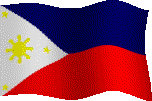
The Philippine Flag has an interesting story. It was made in Hong Kong by Mrs. Marcela de Agoncillo, wife of Don Felipe Agoncillo.
During his exile in Hong Kong General Aguinaldo designed the Filipino flag as it looks today. Mrs. Marcela de Agoncillo sewed it with the help of her daughter Lorenza and Mrs. Josefina Herbosa de Natividad (niece of the national hero Dr. Jose Rizal). It was made of silk with a white triangle at the left containing a sunburst of eight rays at the center, a five pointed star at each angle of the triangle, an upper stripe of dark blue, and a lower stripe of red. The white triangle stands for equality; the upper blue stripe for peace, truth and justice; and the lower red striped for patriotism and valor. The sunburst of eight rays inside the triangle represented the first eight provinces that took up arms against Spain: Manila, Laguna, Pampanga, Cavite, Bulacan, Nueva Ecija, Bantangas, and Tarlac. The three stars symbolized Luzon, the Visayas, and Mindanao. In times of peace, the blue stripe is uppermost, but when the nation is at war, the red stripe is on top.
The flag which Mrs. Agoncillo made in Hong Kong was taken to the Philippines by General Aguinaldo. It was hoisted officially at Kawit, Cavite on June 12, 1898, in connection with the proclamation of Philippine Independence. From that date it has served as the national flag of the Filipinos.
The Philippine National Anthem was composed by Julian Felipe, a Filipino music teacher and composer of Cavite. He finished it on June 11, 1898, and showed it to General Aguinaldo, who instantly liked it because of its stirring melody. The following day the music band of San Francisco de Malabon played it for the first time during the unfurling of the Filipino flag at Kawit during the Independence Day ceremony.
For more than a year the anthem remained without words. Towards the end of August of 1899, a young poet-soldier named Jose Palma wrote the poem titled "Filipinas". This poem expressed in elegant Spanish verses the ardent patriotism and fighting spirit of the Filipino people. It became the words of the anthem, and today the anthem is sung in Pilipino, its official lyrics translated by Felipe de Leon, from the original Spanish lyrics in the early 1900s. There are also English translations, thought by many to be inaccurate, due to the fact that some English versions were translated from the Tagalog version, and other English versions were translated from the original Spanish.
Back to Top
Back to Tagalog for Site Visitors
Back to Tagalog Main Page
LUPANG HINIRANG
(Philippine National Anthem)
Official Filipino Lyrics
Bayang magiliw
Perlas ng Silanganan
Alab ng puso
Sa dibdib mo'y buhay.
Lupang hinirang,
Duyan ka ng magiting,
Sa manlulupig
Di ka pasisiil.
Sa dagat at bundok
Sa simoy at sa langit mong bughaw;
May dilag and tula
At awit sa paglayang minamahal.
Ang kislap ng watawat mo'y
Tagumpay na nagniningning,
Ang bituin at araw niya
Kailan pa ma'y di magdidilim.
Lupa ng araw, ng luwalhati't pagsinta,
Buhay at langit sa piling mo;
Aming ligaya na pag may mang-aapi
Ang mamatay ng dahil sa iyo.English Translation
Land of the morning
Child of the sun returning
With fervor burning
Thee do our souls adore.
Land dear and holy,
Cradle of noble heroes,
Ne'er shall invaders
Trample thy sacred shores.
Ever within thy skies and through thy clouds
And o'er thy hills and seas;
Do we behold thy radiance, feel the throb
Of glorious liberty.
Thy banner dear to all hearts
Its sun and stars are bright,
Oh, never shall its shining fields
Be dimmed by tyrants might.
Beautiful land of love, oh land of light,
In thine embrace 'tis rapture to lie;
But it is glory ever when thou art wronged
For us thy sons to suffer and die.
Back to Top
Back to Tagalog for Site Visitors
Back to Tagalog Main Page
